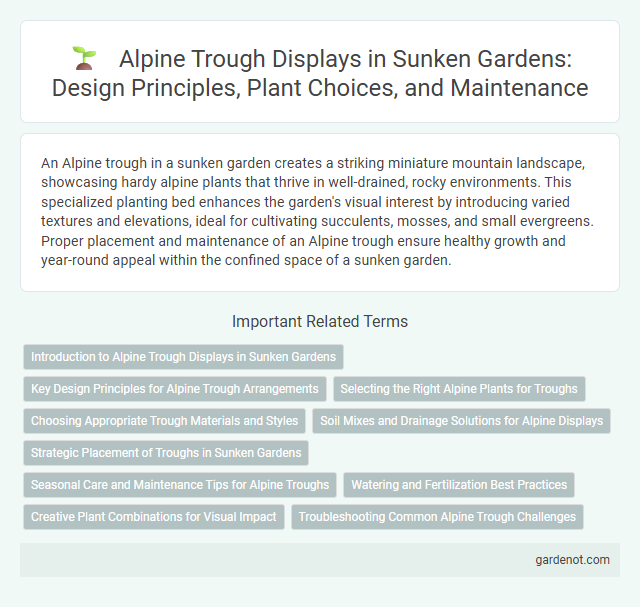An Alpine trough in a sunken garden creates a striking miniature mountain landscape, showcasing hardy alpine plants that thrive in well-drained, rocky environments. This specialized planting bed enhances the garden's visual interest by introducing varied textures and elevations, ideal for cultivating succulents, mosses, and small evergreens. Proper placement and maintenance of an Alpine trough ensure healthy growth and year-round appeal within the confined space of a sunken garden.
Introduction to Alpine Trough Displays in Sunken Gardens
Alpine troughs in sunken gardens offer a specialized method to showcase rock garden plants and miniature alpine species in a controlled, elevated environment. These troughs simulate high-altitude conditions, providing excellent drainage and protection for delicate flora such as saxifrage, edelweiss, and dwarf conifers. Their compact design maximizes space utilization while enhancing the visual appeal of alpine plant displays within the serene setting of sunken gardens.
Key Design Principles for Alpine Trough Arrangements
Alpine trough arrangements emphasize key design principles such as well-draining soil and proper elevation to mimic natural mountain habitats, ensuring plant health and stability. Selecting a variety of alpine plants with diverse textures and colors creates visual interest while maintaining ecological balance. Incorporating rocks and gravel not only enhances aesthetics but also supports root structure and moisture control essential for alpine species growth.
Selecting the Right Alpine Plants for Troughs
Choosing the best alpine plants for a trough requires considering species that thrive in well-drained, rocky conditions and tolerate temperature fluctuations typical of sunken gardens. Succulents like Sempervivum and Sedum, along with dwarf conifers and cushion plants such as Saxifraga, are ideal for maintaining vibrant color and texture in compact spaces. Prioritizing drought-resistant varieties enhances longevity and minimizes maintenance in alpine trough arrangements.
Choosing Appropriate Trough Materials and Styles
Selecting the right materials for alpine troughs in sunken gardens ensures durability and aesthetic harmony with the natural landscape. Common materials include stone, concrete, and weathered metal, each offering unique textures and weather resistance suited for alpine plants. Opting for trough styles that mimic natural rock formations enhances the garden's authenticity and supports optimal drainage for succulent and alpine species.
Soil Mixes and Drainage Solutions for Alpine Displays
Alpine troughs require well-draining soil mixes composed of gritty materials like sand, perlite, and small gravel to mimic mountain conditions and prevent root rot. Incorporating organic matter such as compost or peat moss enhances moisture retention while maintaining aeration necessary for alpine plants. Effective drainage solutions include using porous liners and elevated trough bases to ensure excess water flows away, preserving the delicate roots of alpine species in sunken garden displays.
Strategic Placement of Troughs in Sunken Gardens
Alpine troughs in sunken gardens are strategically placed to maximize visual interest and optimize microclimate conditions for alpine plants. Positioned along pathways or at varying elevations, these troughs enhance drainage and provide ideal exposure to sunlight, crucial for delicate species. Their placement also creates focal points that guide visitors' attention while integrating seamlessly with the garden's overall design.
Seasonal Care and Maintenance Tips for Alpine Troughs
Seasonal care for alpine troughs involves regular inspection and removal of dead foliage to prevent disease and promote healthy growth during spring and fall. Maintaining well-drained soil with a mix of gritty compost ensures optimal root health and reduces the risk of root rot throughout wetter seasons. Winter protection includes mulching and covering troughs with frost cloth to shield delicate alpine plants from extreme cold and frost damage.
Watering and Fertilization Best Practices
Alpine troughs require precise watering techniques to maintain moisture without waterlogging, ideally using drip irrigation or watering early in the day to reduce evaporation. Fertilization should involve a balanced, slow-release fertilizer with a focus on micronutrients such as iron and magnesium to support the delicate alpine plants. Avoid over-fertilizing to prevent nutrient buildup, which can harm roots in the shallow substrate.
Creative Plant Combinations for Visual Impact
Alpine troughs showcase creative plant combinations that enhance visual impact by meticulously pairing drought-tolerant succulents with vibrant alpine perennials. Incorporating contrasting textures and colors, such as silvery foliage alongside bright blooms, creates dynamic focal points within sunken garden designs. Strategic layering of low-growing cushions and trailing plants maximizes depth and interest, elevating the trough's aesthetic appeal.
Troubleshooting Common Alpine Trough Challenges
Alpine troughs in sunken gardens often face drainage issues caused by compacted soil and improper slope design, leading to water retention that harms plant roots. Regularly checking and adjusting soil texture with grit or sand improves water permeability and prevents root rot in alpine plants. Installing a slight gradient and ensuring clear drainage paths are essential to maintaining optimal moisture levels and avoiding common waterlogging problems in alpine troughs.
Alpine trough Infographic

 gardenot.com
gardenot.com